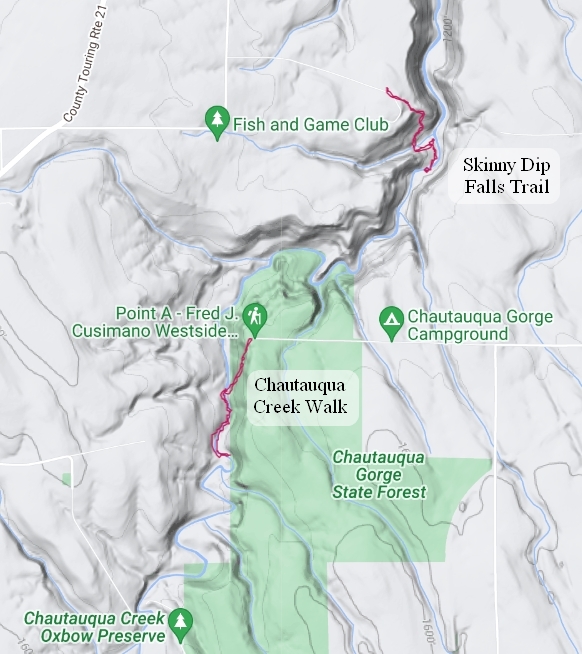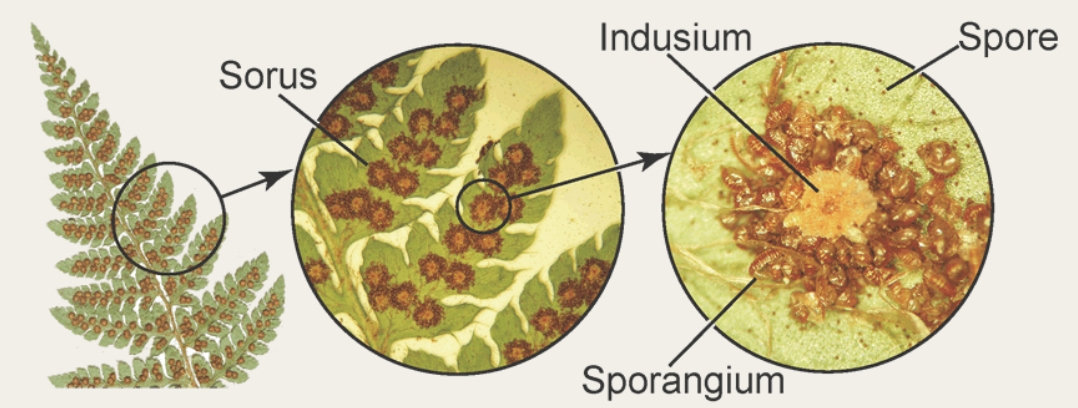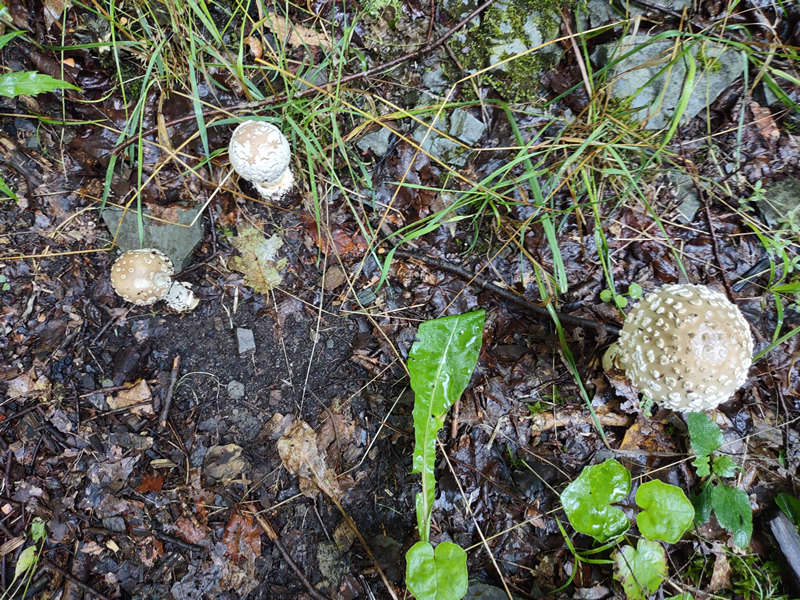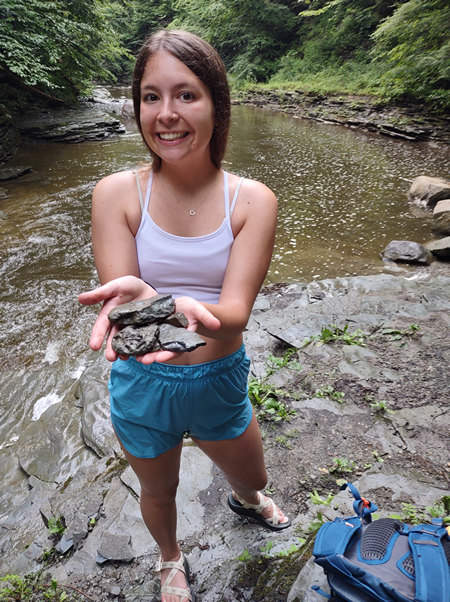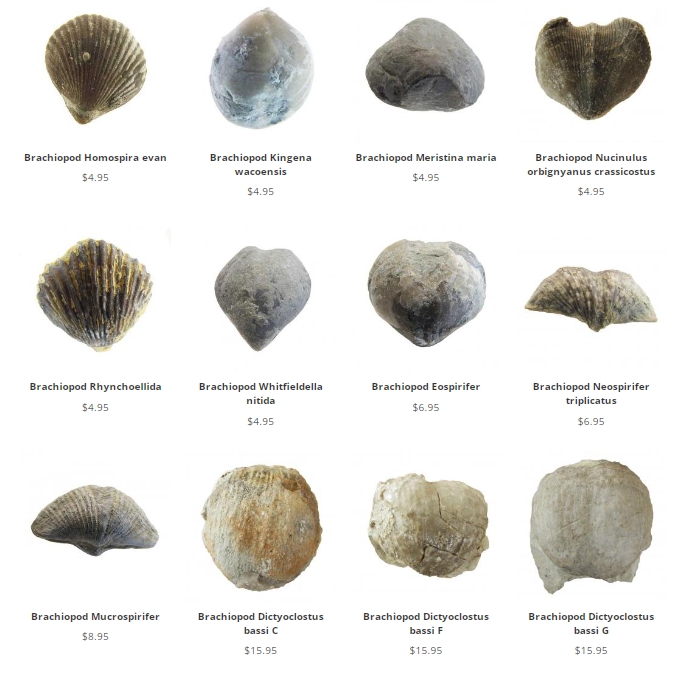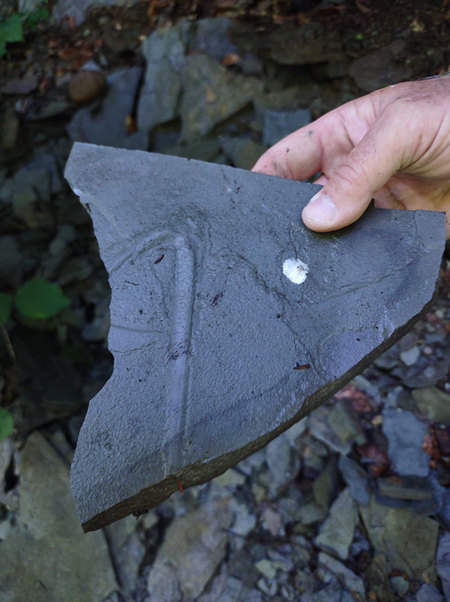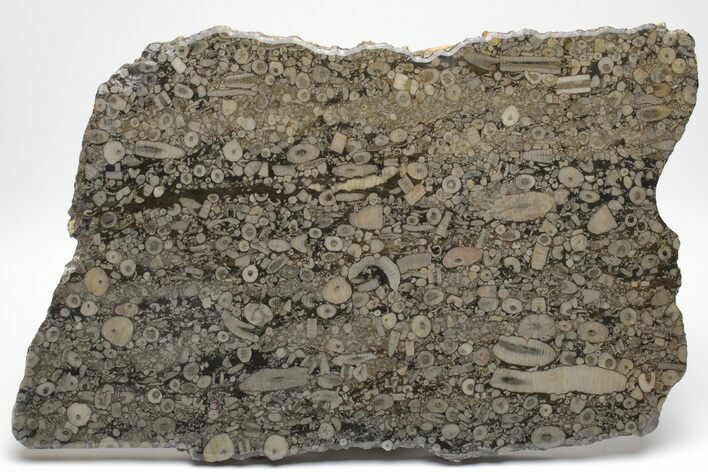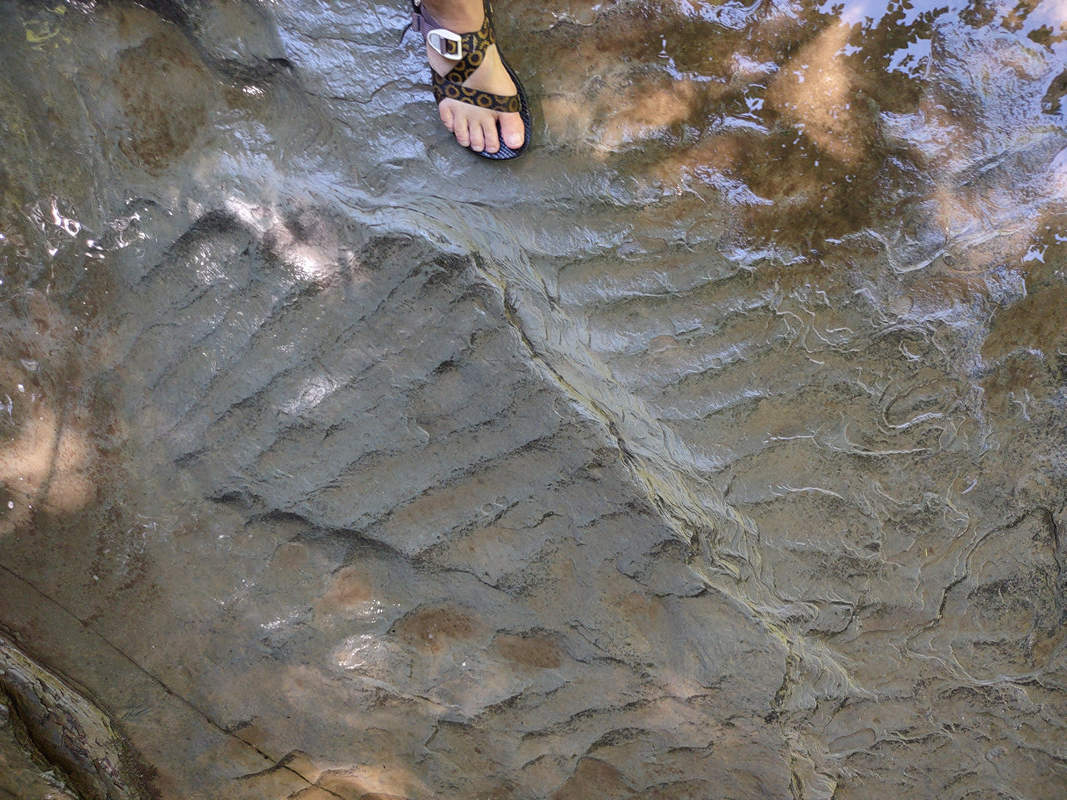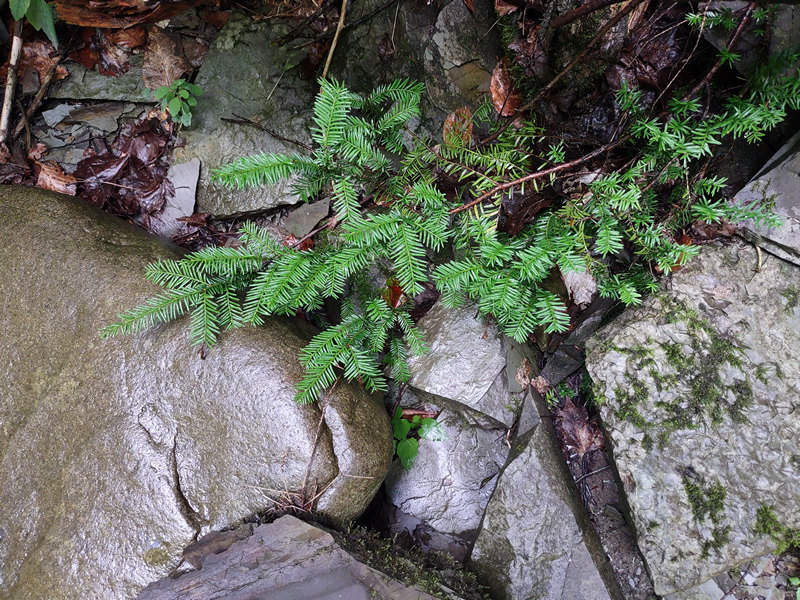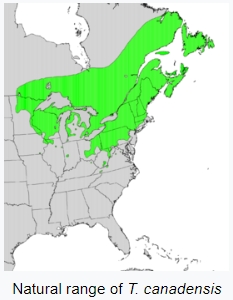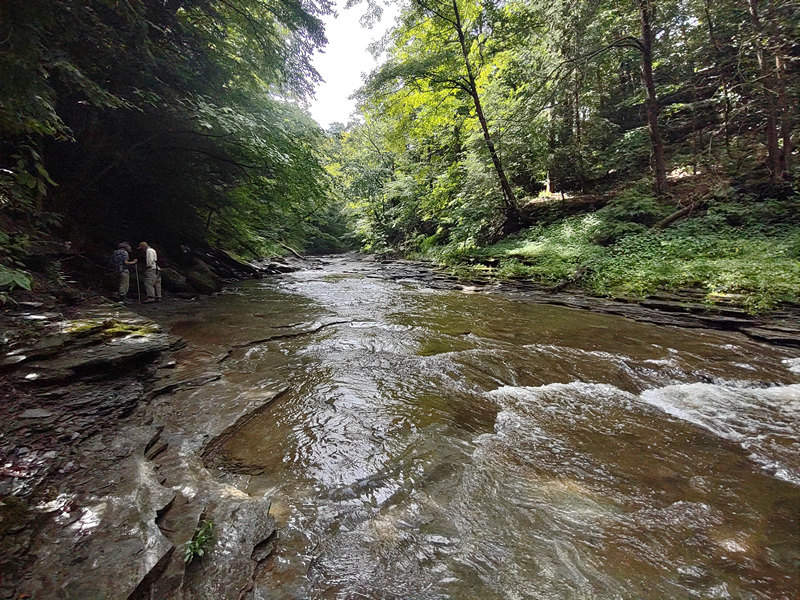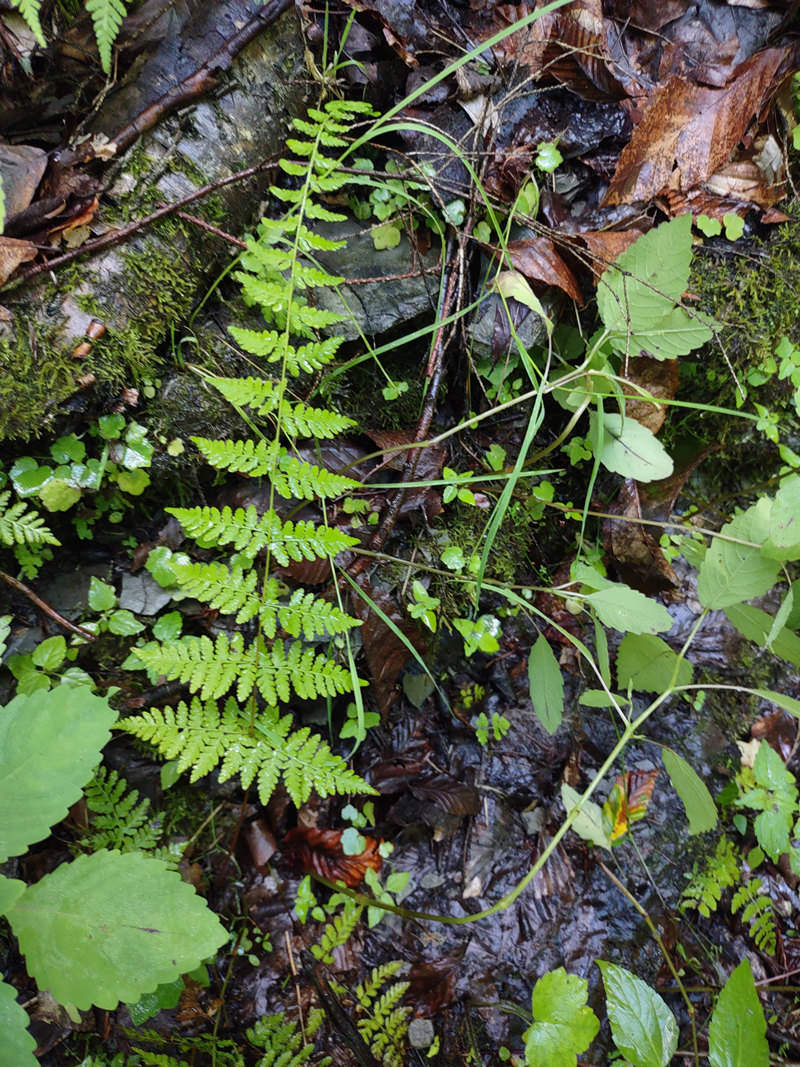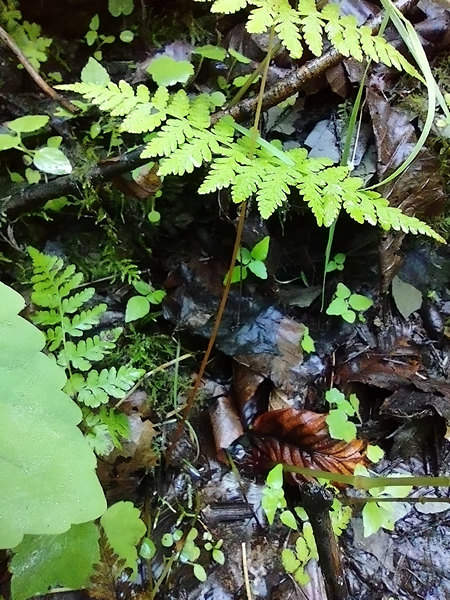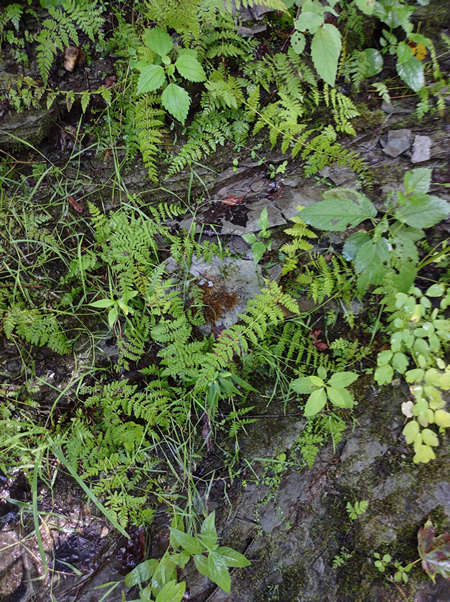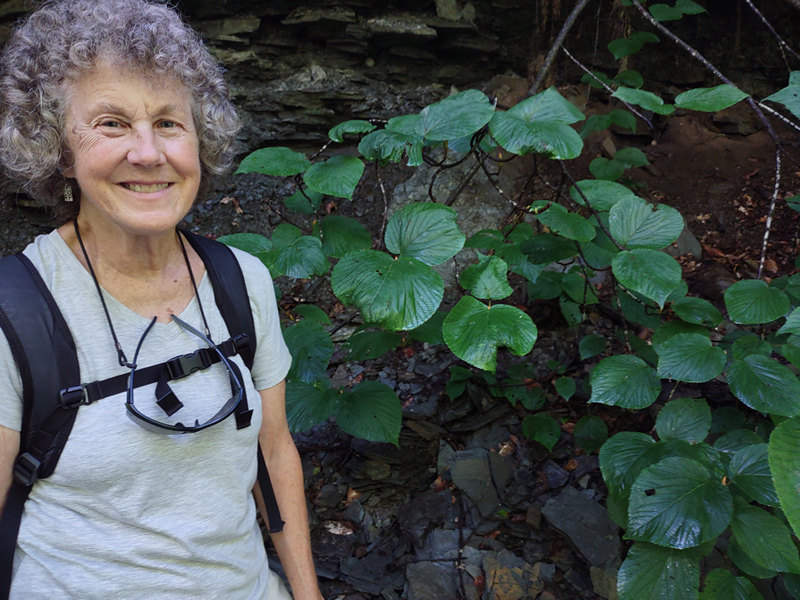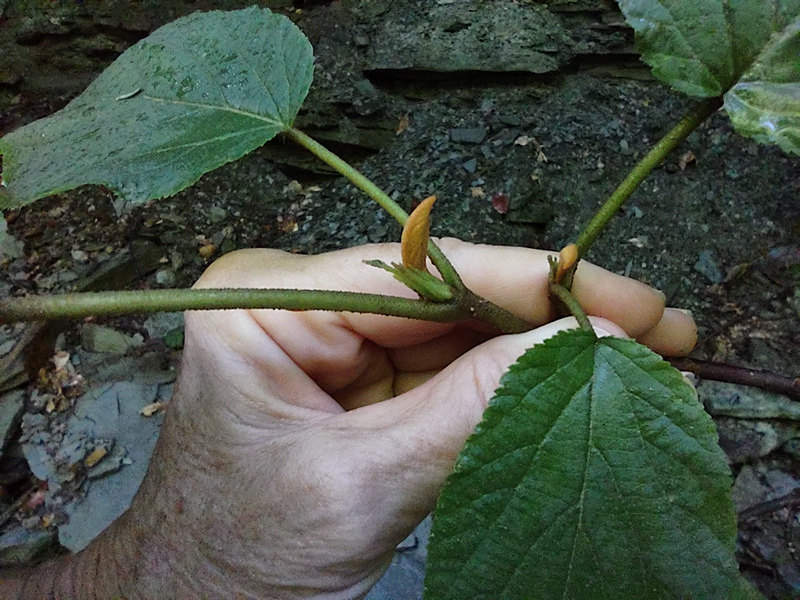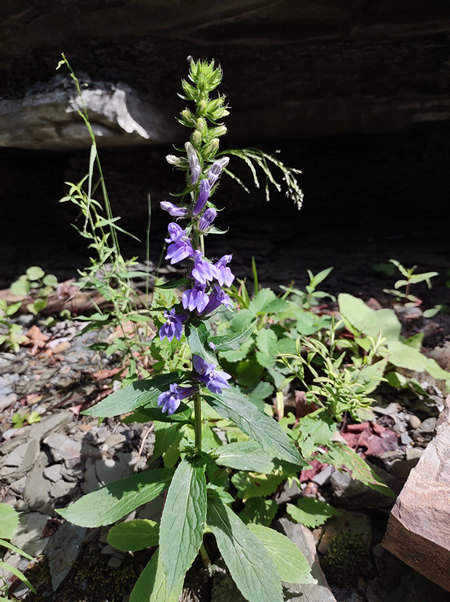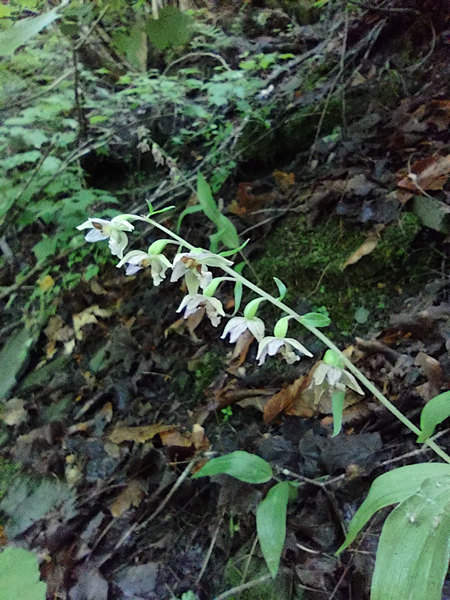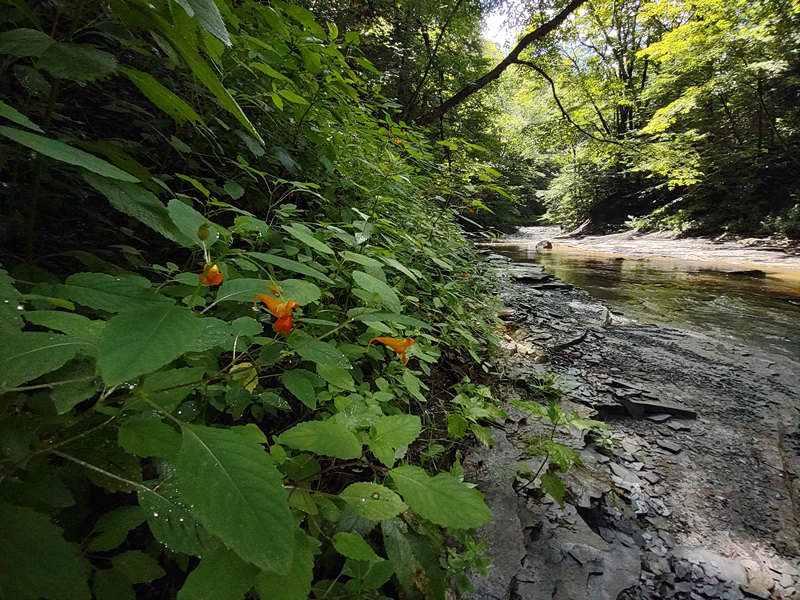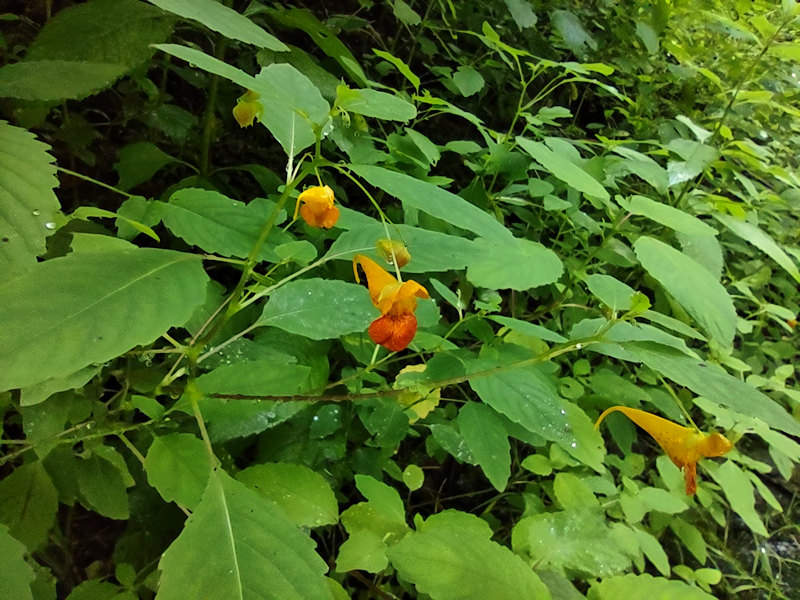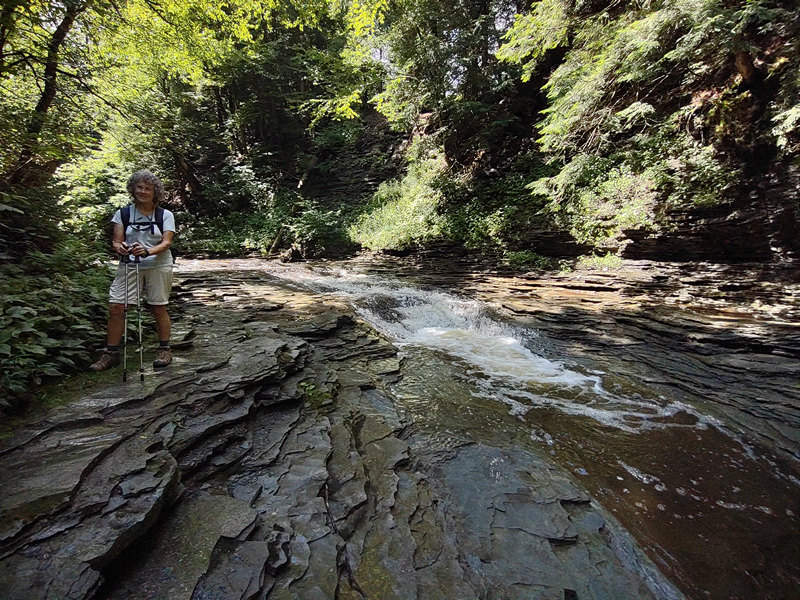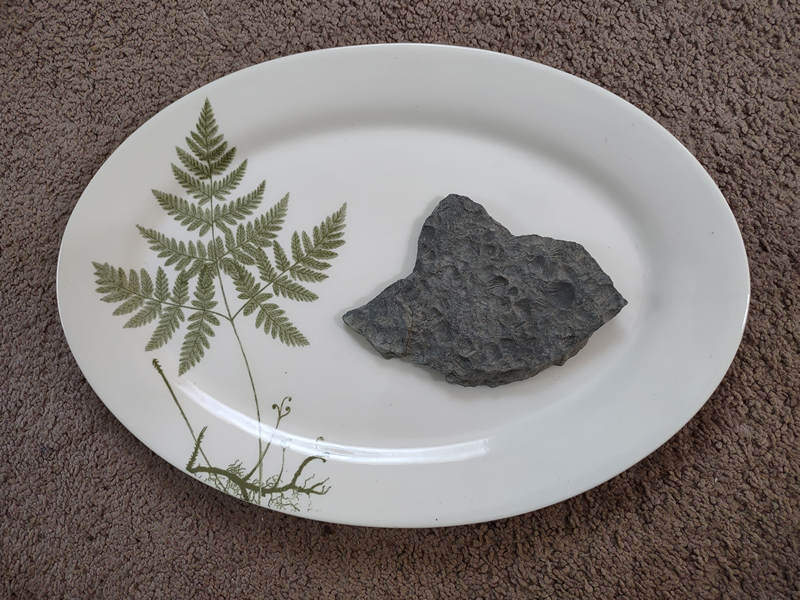Mike Breiding's Epic Road Trips: August 2022
Chautauqua Creek Gorge
Western New York
Tom and Becky take us to a Watery Wonderland of 'Pods, 'Noids and 'Phytes
06 August 2022
Chautauqua Creek Gorge Hikes NY
The last few summers we have stayed pretty close to home. Not much travel. Why? You know - it's that COVID thing. This summer was not much different. We did travel regionally to visit friends and Betsy went to her 50th college Reunion at Heidelberg in Tiffin OH where she graduated in 1972. That was the same year I and others in the family left San Francisco to try homesteading in West Virginia.
But we had no big trips. No flying to Colorado to visit Priscilla, no driving to Wisconsin with bikes in tow to see Deb and pedal a few Rail-Trails. And no visit to our beloved Upper Peninsula which now draws such big crowds I am wondering when we might get back.
What with COVID being over and all (Ha!) we could have safely travelled I am sure but it seemed like every time we thought about it we had "reluctance to get in the car" and that killed our planning. And of course the price of gas!! Even local trips were costing more than we ever thought we would pay. And, hotels are up, rental cars are up - blah, blah, blah, whine, whine, whine.
Becky Berlin got to hear some of this whining in an email I sent her. And, fortunately instead of telling me to shut up and quite acting like a big baby she invited Betsy and me up to her family's place in Harborcreek where she and husband Tom spend some time.
Tom followed up with some suggestions of things we could do while visiting them in Harborcreek. One of those suggestions was exploring the Chautauqua Creek Gorge in western New York.
Betsy and I had been in the general area before when we visited the Zoar Valley way back in 2003. The Zoar Valley is an area of deep gorges along the Main and South branches of Cattaraugus Creek, and Chautauqua Creek looked like it might be similar. So Chautauqua Creek Gorge was our first choice.
Now just who are Becky and Tom Berlin?
I first met Becky and Tom at a Brooks Bird Club Foray back in the late 70s. They were fledgling birders and were there to learn from the Masters like Glen Phillips, Ralph Bell and Nevada Leitch, all now deceased.
A number of years would pass before I saw Becky and Tom again. But this time it would not be birding related, it would be biking related. It turns out like Betsy and me they were also members of the Harrison County Bicycling Association (now Country Roads Cyclists). One year they showed up at a club picnic at Prickett's Fort State Park. I must confess I barely recognized them but I did and we were able to get re-acquainted and Tom and Becky got to meet Betsy.
Not long after that, Becky and Tom invited the bike club members to join them for some cycling and kayaking in the Emlenton area and stay at their vacation cottage in Emlenton PA. We had a nice group and some of us pitched our tents in the yard for the stay over. The place was nicely situated along the scenic Allegheny River and nearby Allegheny Valley Rail Trails which included the Allegheny River, Samuel Justus, Sandy Creek, and Oil Creek Rail Trails. The house was directly across from the Allegheny River so Tom and Becky put the word out folks might want to bring a canoe or a kayak along with their bike so Betsy and I did just that.
I was curious about the Emlenton house and how Tom and Becky came to own it. So I asked. Tom had this to say.
The Emlenton house was a family home. It was my great grandparents on Grandma's side (Harper) home. My grandparents (Berlin) moved there in late 30s from farm living in Ohio and then PA. Farming came after oil field work in Oklahoma and West Virginia. My Grandma really did not like living on a farm or in tents in the oil fields and wanted to move back to town so they moved to the place in Emlenton. The old house flooded numerous times and I remember water going in and out first floor Windows.
I spent a lot of summers there on the river. I loved that old musty place. The original two story house was torn down and the current little vacation home built in its place.Source: Tom Berlin
That was a fun weekend and spending more time with Tom and Becky cemented our relationship. I am glad for that as they just live down the road a bit on an idyllic off the grid homestead which we love to visit.
And so that leads into our next get together with Becky and Tom. Becky and Tom had mentioned previously that we would be welcome to visit them in Harborcreek PA where they had a place which had been in Becky's family for many years. So in May of 2016 we planned our first visit to Harborcreek.
It was only about half an hour from Presque Isle State Park where Betsy and I had pedaled all those years back. Perfect!
We have now been to the house at Harborcreek a number of times and we were looking forward to this latest trip up to the Land of Lake Erie.
I should mention the Emlenton cottage was eventually sold and now Tom and Becky focus their time and attention on the house and grounds in Harborcreek as a retreat from the Homestead in WV.
In their own words
Tom Berlin and Becky Anderson grew up in Harborcreek and graduated from Harborcreek HS, Becky near the top of her class in 1968 and Tom below the middle of his class in 1967. They knew each other in High School, as Tom was friends with Becky's older brother, though Becky thought Tom was "rude and unfriendly" in those days.
Both graduated from Penn State, Becky in Zoology, Tom in Forest Science, in 1972. Got married one month later (lucky day for Tom)
Grad school at WVU, where Tom mostly majored in white water kayaking, caving, biking, and nature study. Becky earned MS in Forest Recreation/Therapeutic Recreation.
Settled in Lewis County mid 70s. Bought cheap land with no electric service. Been off electric grid ever since. Fortunately the farm comes with natural gas, so called "free gas", with all its included benefits and drawbacks.
Have been involved with Oglebay Institute, Brooks Bird Club, WV Highlands Conservancy, Sierra Club, plus various other biking, paddling, and other environmental and outdoor groups.Source: Tom Berlin
I (Becky) grew up in Harborcreek, Pa, a farming community outside of Erie. My parents had a 100 acre farm that was a piece of the original Henry Clark farm. The Henry Clark cemetery is on this property, as are 2 of the remaining barns. When I was a child, there were 4 or 5 standing barns, and a working stone dam that filled the ice pond, for the Clark family iceboxes. Of course, the road was dirt, and neighbors were few.
Dad worked the farm by day (cattle, pigs, a milk cow etc) and then went to work on the evening shift at GE. He also took courses off and on at Gannon University in Erie.
Mom had a degree in home economics, which was good as she raised 4 kids, multiple gardens, canned everything, produced the best pies and meals in a very tiny, hot kitchen, and still had to iron dresses for school, as that was required attire all through my school years.
As with most kids then, my first money came from picking fruit, mostly blueberry, cherries, and grapes. The truck picked us up at the corner, with all the other kids hanging out the back. At the orchard, you were not allowed to place your own ladder...you had to call "Ladderboy!", and wait. Ladderboy always helped the cutest girls first.Source: Becky Berlin
I was curious about whether the orchards were still there 50 years later so I queried Becky.
Oh yes, there are plenty of orchards, but they have converted to small trees...either dwarf, or grown on wires. Most of the grape fields are on wires for a picker machine that shakes them off.
Mom always used to pick, and tie grapes in February, for "pin money". The school bus would drop me off at the field so I could pick after school. I tried tying grapes in February, also, but did not even last the day! A cold, wet wind always blows across the grape field and you had to wear fingerless gloves. It was so miserable! Only women worked the fields.Source: Becky Berlin
Now that Tom and Becky are retired they are taking nice camping and boating trips and they even visited us in Tucson. When not enjoying their chores on the Homestead or Harborcreek they find time to volunteer at the The Museum of American Glass in West Virginia which is located in Weston WV.
Becky took Betsy and me on a tour of the Museum last summer. It was quite amazing. And overwhelming.
The Collection
Spanning the 19th century through the present time, some 18,000 pieces of virtually every type of American glass are on public display with at least that much additional glassware in open storage, available for research and study. Many clubs and individuals have donated collections and/or display cases to be dedicated to specific kinds of glass. Some past examples are: Steuben Glass from the late Broadway producer Martin Massman's estate; Cameo glass by West Virginia artist Kelsey Murphy and glass paperweights from the Degenhart Museum.Source: WikiPedia
If you are ever anywhere near Weston I suggest stopping by to visit the Museum. Betsy and I have no particular interest in glassware but I am sure you will find the Museum just as interesting as we did. They have some real beauties there which are worth seeing and some oddities as well. It is a fun and educational place to visit.
With this long winded introduction I think I have reached new heights in verbosity.
So let's get going - shall we?!
OK - it's time to get oriented.
The purple dots on the map show Morgantown WV, Harborcreek PA and Chautauqua Creek Gorge NY.
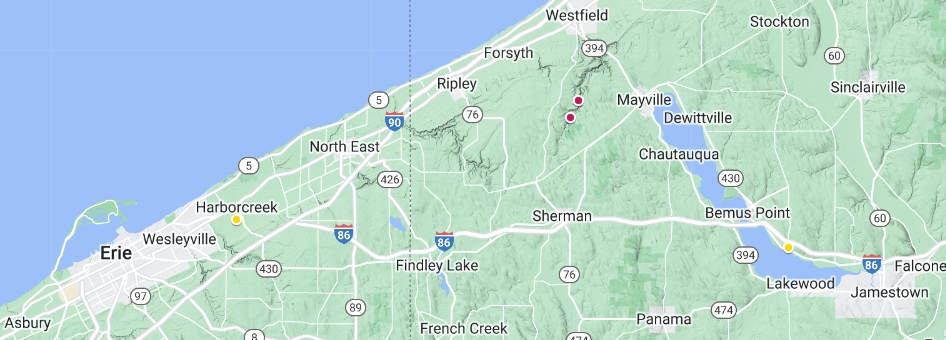
A closer look. The two purple dots represent the two hikes we took in the Chautauqua Creek Gorge. The yellow dot near Erie is Harborcreek and the yellow dot near Bemus Point is the Chautauqua Lake Rest Area and New York Welcome Center which was our last stop for the day.
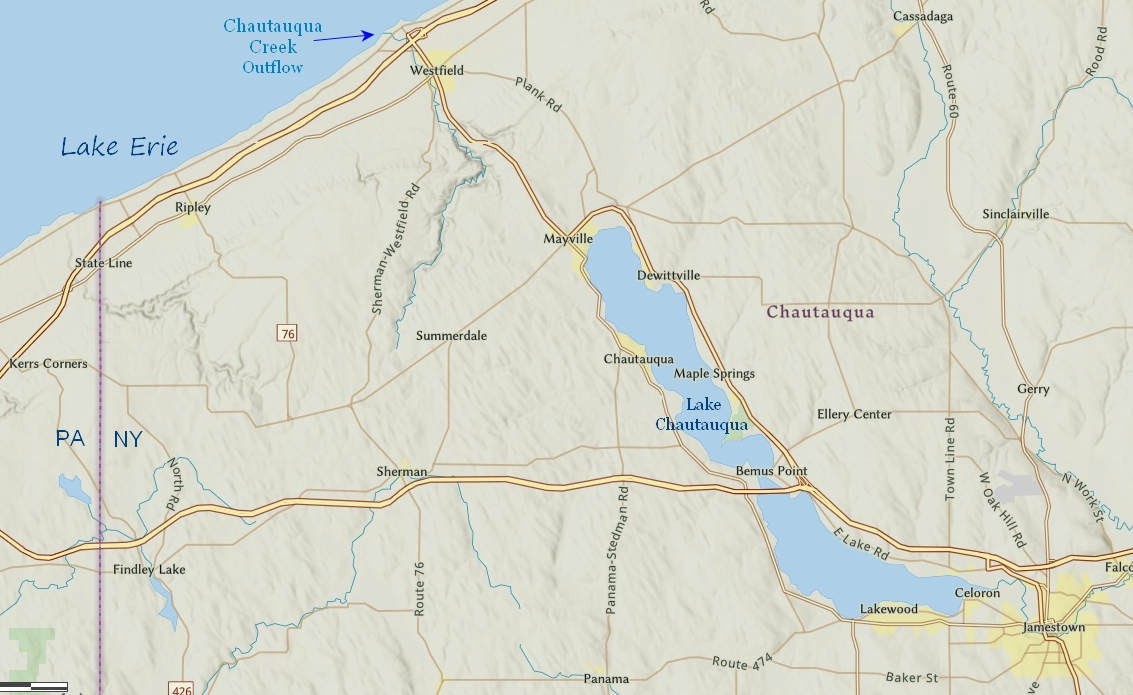
This map faintly shows Chautauqua Creek and its out flow at Westfield into Lake Erie.
Chautauqua Creek is a tributary of Lake Erie, approximately 15 miles (24 km) long, in the southwestern corner of New York in the United States. The headwaters of the creek rise in the town of Sherman, in Chautauqua County, and flow in a northerly direction through the town and village of Westfield where they empty into Lake Erie. For much of its length, the creek serves as the boundary line between the towns of Westfield and Chautauqua.
Source: WikiPedia
Here is a look at the Chautauqua Creek Gorge and the two "hikes" we took there. Hikes in quotes because they were more like walks than hikes the distance total being about 2.5 miles. However, we saw a lot in those 2.5 miles. And since this area was new to Betsy and me it made it even more enjoyable.
If you look at the northern trail line it seems to drop off a precipice into the gorge. It was steep, but not that steep. The trail followed a rutted out old roadway which had some deep washouts with shear sides. We all had to watch our step.
This section of Chautauqua Creek is a well known nude swimming area although we saw no one that day. Too early in the day I suspect. The area is also popular with anglers who hope to hook wild brown or steelhead (rainbow trout), which make seasonal runs up the creek from Lake Erie
Click on the photos below for a larger image.
NOTE:
Photos were taken with a phone camera.
High resolution images are of poor quality.
⋄⋄⋄⋄⋄⋄⋄⋄⋄⋄⋄⋄⋄⋄
Hike № 1: Skinny Dip Falls Trail
When we weren't busy watching our footing we could enjoy the luxuriant stands of the Maidenhair fern (Adiantum pedatum). These were the largest and most robust plants I had ever seen.
The genus name "Adiantum" is derived from the Greek word "adiantos" meaning "unwetted" – a reference to the way the fronds repel water.
The soft green color of the fronds and the contrasting black stems make this fern a real standout.
We also saw some nice specimens of the Intermediate wood fern (Dryopteris intermedia). The so called "wood ferns" (Dryopteris) are also known as "shield ferns" alluding to the indusuium which is a thin membranous covering over the sorus. The sorus is a cluster of spore-producing receptacles on the lower (abaxial) surface of a fern frond.
The above illustration is from the US Forest Service web page entitled "Fern Structure".
I have found the USFS pages about ferns clearly written and easy to digest. If you are hungry for fern info you might want to give the USFS fern pages a nibble.
The wood ferns are a promiscuous bunch and hybridize freely with each other. Wanna know more? Check out the paper "Unraveling reticulate evolution in North American Dryopteris (Dryopteridaceae)" by Emily Sessa, et al. Below is an extract.
Dryopteris is a large genus (ca. 225 species) with a nearly cosmopolitan distribution , including thirteen species in North America north of Mexico . This latter assemblage is one of the most widely studied groups of ferns in North America, and has long been thought to involve extensive reticulate evolution via allopolyploid hybridization . The group includes seven sexual diploid taxa, five sexual tetraploids, one sexual hexaploid, and 29 sterile hybrids (more than are known from any other fern genus in North America).
Source: National Library of Medicine
Here is a plant you don't want to nibble. This is one of the species of Amanita, possibly A. pantherina the Panther amanita.
Mushroom pickers beware!
The genus Amanita contains about 600 species of agarics, including some of the most toxic known mushrooms found worldwide, as well as some well-regarded edible species. This genus is responsible for approximately 95% of the fatalities resulting from mushroom poisoning, with the death cap accounting for about 50% on its own. The most potent toxin present in these mushrooms is a-amanitin.
Source: WikiPedia
We walked along the creek for a short ways. The area was heavily over used with muddy ORV tracks and make shift campsites. After a bit Tom and Becky suggested we check out another area of the creek so we made our way back up the hill and were soon walking in one of the prettiest areas Betsy and I have ever been in.
Hike №2: Chautauqua Creek Walk
Our next hike was a short distance to the south and accessed via Hannum Road which dead ended in a parking area. The last half mile or so of this road was flanked by Chautauqua Gorge State Forest camp sites. As we drove by the sites with dogs, kids, radios, generators and loud mouthed adults we could only imagine what it would be like that evening when everyone had their campfires going. Not a quiet place...
Once again the "trail" down to the creek was an old road bed but the surface and grade were much easier to negotiate.
As we approached the end of the trail we could now see the creek and 3 kids playing in the water.
Here are the "kids". We noticed they were scanning the water looking for something and we soon found out what.
Fossils! It turns out this "kid" is a geology student at Penn State and hoped to major in Planetary Geology. But, for the time being Chautauqua Creek fossils were holding her interest and she proudly showed us her finds for the day.
Fortunately for us Tom has an interest in geology and he was soon pointing out all the goodies he noticed. Here we have a boulder with many pieces of brachiopods.
Brachiopods have a very long history of life on Earth; at least 550 million years. They first appear as fossils in rocks of earliest Cambrian age and their descendants survive, albeit relatively rarely, in today’s oceans and seas. They were particularly abundant during Palaeozoic times (248–545 million years ago) and are often the most common fossils in rocks of that age.
Brachiopods vary considerably in size. The aptly named Carboniferous genus Gigantoproductus may grow up to 30 cm across. In contrast, the Jurassic rhynchonellid genus Nannirhynchia is minute, generally only two or three millimetres across — the size of a large pin head.
Source: British Geological Survey
According to WikiPedia there are about 100 living genera and about 5,000 fossil genera. One might ask - if there are that many genera how many species of Brachiopods are there?
It began to seem like every rock and slab was chock full of fossils.
There is a big market for fossils of all kinds including brachiopods. And apparently they come in various shapes and sizes. New to me! But, then again I never thought much about it. Until now they all looked like "sea shells" to me.
The above is a screen shot of some of the offerings at fossilicious.com.
Brachiopod Shapes
Brachiopods have a variety of shapes, and the classification of brachiopods is based partly on shape. Two basic aspects of shape are the appearance of the brachiopod from (1) the side or lateral view, which is called its profile, and (2) from the top or bottom view, called its outline.Brachiopod profiles
Brachiopod profiles are commonly described with a terminology based on the curvature of the valves. A compound-word term describes first the curvature of the brachial (dorsal) valve, followed by the curvature of the pedicle (ventral) valve.Source: The Kentucky Geological Survey
And just what are those "compound-word terms" ? Click on the link above to learn more.
A crinoid stem? Tom had seem some previously he was sure about but he was not positive this one was a crinoid stem. Since I didn't get a good photo of the ones found previously below is one I borrowed.
Photo: Copyright © 2022 FossilEra
The above specimen is for sale and can be yours for $175.00.
This is a large slab containing crinoid stems and various other crinoid segments, in marble. It has been cut flat on both sides and later covered with a clear epoxy giving it a glossy, polished appearance. Comes with an acrylic display stand.
Crinoids, sometimes commonly referred to as sea lilies, are animals, not plants. They are echinoderms related to starfish, sea urchins, and brittle stars. Many crinoid traits are like other members of their phylum; such traits include tube feet, radial symmetry, a water vascular system, and appendages in multiples of five (pentameral). They first appeared in the Ordovician (488 million years ago) and some species are still alive today.
Source: Copyright © 2022 FossilEra
We did not see anything remotely resembling the slab above but it was fun looking for them to see what fragments could be found.
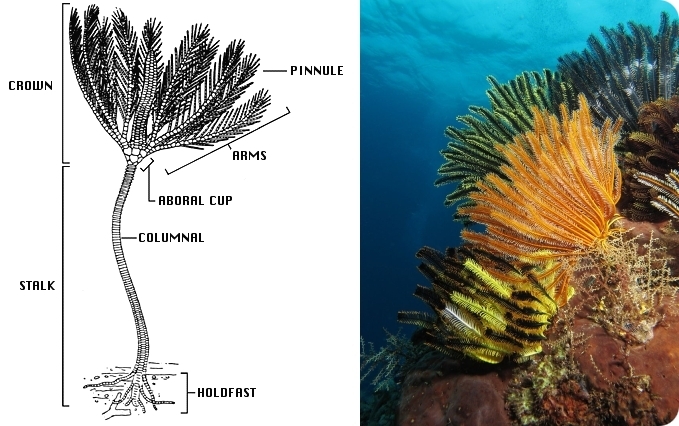
Crinoid anatomy and colorful crinoids in shallow waters in Indonesia.
Source: WikiPedia
All this talk about crinoids brought to mind another "Tom": Dr. Thomas W. Kammer Professor Emeritus of Geology WVU. Somewhere along the way Tom became Crazy for Crinoids and has produced numerous papers about them. Included amongst those papers is the real page turner and a must read for all crinoid fans: "The 'Age of Crinoids': A Mississippian Biodiversity Spike Coincident with Widespread Carbonate Ramps". Or, in my own words: "The Rise and Fall of the Mississippian Crinoids". Hey! Some people are Crazy for Crinoids and others are Fern Freaks. Plenty of fun for everyone.
Sorry, we are not done with crinoids yet. Remember the movies "Alien/Aliens"?
Apparently some think the Alien face hugger was modeled after a crinoid.
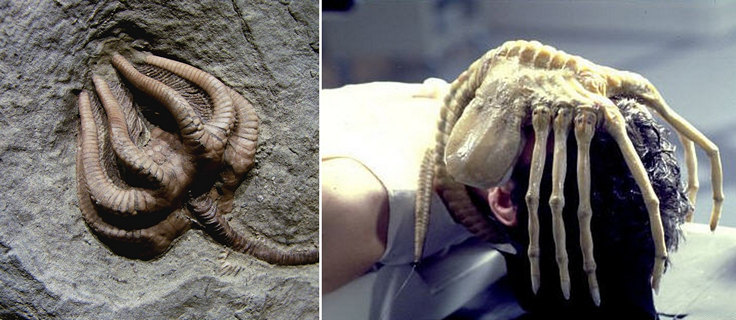
Oooooooo! Icky!
OK, that's enough about crinoids.
Some of the thin siltstone layers exhibited ripple marks. Ripple marks form when waves or water currents move across loose sediment.
Over time, the sea retreated and the sandy sea floor dried and turned into stone in a process known as lithification. This preserved the shape of the ripple marks.
Source: nps.gov
Here Tom and Becky examine a rock which stood out from all the rest we had seen thus far.
Tom was pretty sure the glassy, jagged junks were chert, also known as flint. Both are a type of quartz.
Quartz commonly shows up in sedimentary rocks as rounded pebbles or as angular to rounded sand grains. Quartz grains freshly released from a weathered rock can be quite angular, but river transport followed by repeated pounding by ocean waves or eolian transport can make the grains remarkably spherical.
Chert and flint are microcrystalline varieties of quartz. Their quartz crystals are so tiny that chert and flint fracture more like glass than quartz crystals. A skilled person can chip chert and flint pieces into arrow heads, spear points, and other tools. The only difference between chert and flint is color: flint is black or nearly black and chert tends to be white, gray, or pink and can be either plain, banded, or preserve fossil traces.
Source: Charles E. Jones - pitt.edu
I decided to get an expert opinion as to whether this was chert or not so I contacted the author of the above info which is from the web pages of Geology and Planetary Science at Pitt.
It’s hard to tell for sure from just the photos that what you’ve got is chert, but it certainly seems most likely. I usually check hardness to be sure: The tip of a jackknife won’t scratch it.
Chert often forms in limestone. In West Virginia and Pennsylvania when I’ve seen it the chert is nearly black and forms irregular horizontally elongate blobs. Chert often forms from silica that was once an opaline silica that made sponge spicules or such microfossils as diatoms or radiolarians. These might be concentrated in layers in the originally soft calcareous ooze, and as the ooze transitioned to hard limestone, the unstable opaline silica dissolved and recrystallized as chert.
I don’t know specifically why the chert was so irregularly distributed in your sample, but often times limestone is heavily burrowed by things like marine worms and arthropods, so maybe they stirred up any original layering in your rock. The photo in which your hands are on the rock looks like it shows such bioturbation.
LOTS of new words for me in the above: spicules, bioturbation, radiolarians. And "soft calcareous ooze"? Gotta love it!
Thanks, Charlie!
If you are interested in finding out more about chert the WikiPedia entry has more information.
OK! Enough about dead stuff.
Let's check out some of the Gorge flora.
Back home in Morgantown I would have immediately labeled this as a Joe-Pye weed (Eutrochium purpureum). But up here we were seeing plants which were much shorter and some with intensely pinkish/purple flowers. And this plant had a flower head that is more flat topped than the large rounded and spreading flower heads we see at home. So, what species is it? I do not know. Do you? If so, please let me know.
I was delighted to see this plant as it is quite rare in our home state of West Virginia. This is Canadian yew (Taxus canadensis) and in WV it occurs in only the coldest spots and highest elevations in the state.
Most of its range is well north of the Ohio River. It is, however, found as a rare ice age relict in some coves of the Appalachian Mountains. The southernmost colonies are known from Ashe and Watauga Counties in North Carolina.
Source: WikiPedia
What a beautiful spot. And since we started our walk we have seen nary a soul.
We found a nice place for lunch and tarried awhile.
Another treat! This is the Bulblet fern (Cystopteris bulbifera). This delicate fern prefers moist areas with limestone so it is in the right place. As with most ferns it reproduces by spores but also has another method which is quicker - round propagules (bulblets) form along the rachis and/or pinnae stalk (costae); these eventually fall off and form new plants. Not all fronds have spores or bulblets; the earliest fronds are mostly sterile and tend to be smaller than later fronds, which are mostly fertile.
Source: WikiPedia
A look at a bulblet of the Bulblet fern. We have this in our fern garden in Morgantown and it is a very rapid spreader due to the number of bulblets which fall to the ground and form new plants.
The reddish stem of the Bulblet fern make it easier to identify than most of the 7 Cystopteris species and hybrids of which about 20 are known.
This is often how one finds the Bulblet fern - tumbling down rocky slopes, the bulblets dropping from the fronds and falling and producing new plants.
Two Beauties!
Here is a plant I had not expected to see, the so called Hobblebush. It has pendulous branches that take root where they touch the ground. The slightly wooly and cinnamon colored leaf buds are very distinctive. These rooted branches form obstacles which easily trip (or hobble) walkers – hence the common name.
I first saw Hobblebush in the late 1970s while on a field trip with Dr. Roy B. Clarkson. Roy was with the WVU Department of Biology from 1956 and retired as professor emeritus in 1992. He shared an office Dr. Earl L. Core. Core co-authored the 4 volume Flora of West Virginia. Directly adjacent to their office was the office of Elizabeth Ann "Betty/Libby" Bartholomew who was the WVU herbarium curator. Libby was my botany mentor and we spent many hours together working in the herbarium and in the field collecting specimens or just "plant watching". All three of these folks always had time for me when I would stop by their office with a question or a specimen to look at and they were always encouraging and helpful.
Here are a few stray Hobblebush fruits and the conspicuous leaf buds.
Here is a rather poor shot of a very showy plant - Great blue lobelia (Lobelia siphilitica). It is generally found in wet, sunny spots like this hillside seep or in wet roadside ditches and along the margins of lakes. The Great lobelia has an interesting pollinating mechanism.
Although self-compatible, a flower is unable to offer pollen to itself and it must be pollinated by insects, primarily bumblebees. Bees use the lower three fused petals as a landing pad. A bee of correct weight will depress these petals on its way to the flower's nectar, this lowers the stigma wiping it against the bee's back.
Source: WikiPedia
The specific epithet "siphilitica" originates from the belief by early European settlers it could cure syphilis. I'll bet that disappointed more than one syphilitic pioneer.
This little orchid is known as Broad-leaved helleborine (Epipactis helleborine). It is native to Europe, Asia, Portugal and China, as well as northern Africa. It was introduced to America and is now so widespread and common I have heard it referred to as the House sparrow of the orchid world.
What a beautiful, interesting and relaxing place to spend a summer afternoon.
The Orange jewelweed (Impatiens capensis) shown here is kin to the Yellow jewelweed (Impatiens pallida) which is the more common jewelweed back home in West Virginia. Betsy and I love jewelweed and have cultivated a forest of it at Cabin №18 in Morgantown.
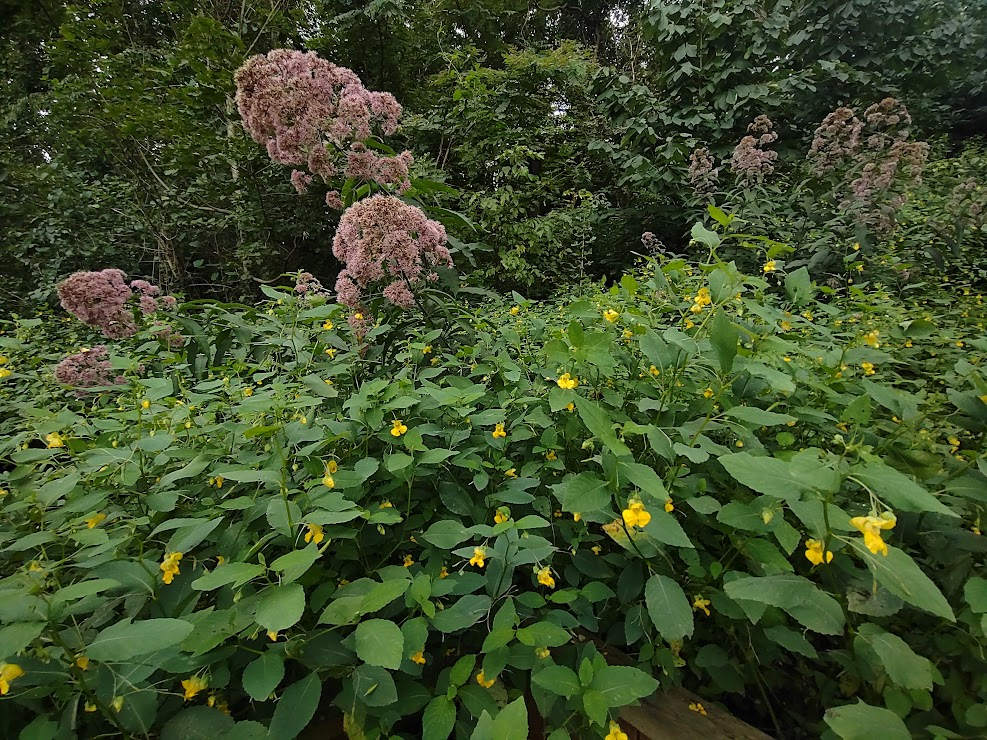
The Jewelweed Forest at Cabin №18.
And so ends another wonderful hike in the woods. Thanks, Tom and Becky! We will be back.
After we left the Gorge we drove over to the Chautauqua Lake Rest Area & New York Welcome Center to use the facilities and take in the view of the lake.
And then it was back to Harborcreek via a rather circuitous route selected by Google Maps. We enjoyed the country scenery and small towns along that quiet route.
The next day it was back home to West Virginia for the four of us.
Here is my brachiopod keepsake for the trip which Betsy graciously carried out of the gorge.
And there you have it: a weekend of brachioPods, criNoids and pteridoPhytes.
See you next time...
Mike and Betsy

